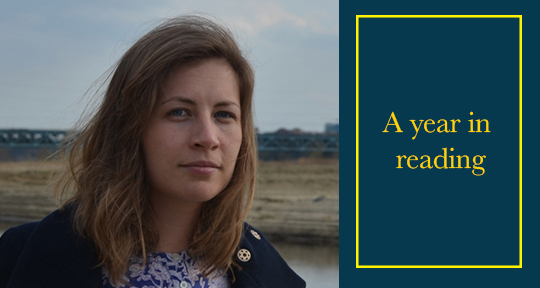Editor-at-Large for Hungary Diána Vonnák, who joined us in October this year, moved between fiction and nonfiction titles in 2017. Some of these books blurred the lines between both and probed the relationship between invented worlds and our own.
I spent much of this year reading books I would have trouble classifying either as fiction or nonfiction. They reminded me of Geoff Dyer, who began his “Art of Nonfiction” interview with the Paris Review by protesting the division: “Fiction, nonfiction—the two are bleeding into each other all the time.” They do, and the result is often great. Here are my favourites from 2017.
I started the year with Philippe Sands’ East West Street: On the Origins of Genocide and Crimes Against Humanity, an engrossing family memoir-cum-intellectual history. Sands, a human rights lawyer, sets off on a journey to recover his own family history—which leads him back to Lviv, a city in Western Ukraine. Before the Holocaust eliminated its prolific Jewish life, Ralph Lemkin and Hersch Lauterpacht, who would later become legal scholars, both studied there. Just like Sands’ own grandparents, Lemkin and Lauterpacht left their hometowns and were spared from the massacre that eradicated their entire families. Sands combines a precipitating personal memoir with a vivid reconstruction of how the Holocaust led these two thinkers to develop the notions, in Lemkin’s case, of genocide and, in Lauterpacht’s case, of crimes against humanity. Sands shows how their ideas originated from their personal lives, and as he follows Lemkin and Lauterpacht through emigration, he reconstructs their respective intellectual environments. It all culminates in the milestone legal debates that took place after the Holocaust—Sands shows us how Lemkin’s and Lauterpacht’s own compelling circumstances shaped their arguments. It is rare to see legal history woven so seamlessly into personal reflection.
A happenstance find in a bookshop led me to revisit Carlo Levi’s 1945 classic, Christ Stopped at Eboli. Levi was an antifascist activist exiled by Mussolini’s government to a remote corner of the Italian south. The title refers to a local saying: Salvation, whether a result of the church imposing its moral agenda, or of the state imposing modernization, has stopped short of reaching this barren land. Villagers in this forsaken part of Italy lack medical care and mistrust their priest to the extent that they resort to their own strange blend of Madonna-infused mysticism in times of spiritual need. Levi, a doctor by training, manages to win their trust and succeeds in treating the villagers. Christ Stopped at Eboli blends the accuracy of a journalist with lyricism and compassion. The result is an understated portrait of a bygone Europe, delivered without exoticism and the sulky romanticism that so often spoils this kind of writing.
Another book on the Italian countryside that left an impression on me was Michaela Murgia’s Accabadora. The novel introduces elements of magical realism into an otherwise realistic portrait of village existence. Murgia, a native of Sardinia herself, brings alive a custom that might have existed, but has never actually been documented. Only Sardinian folklore has spoken of angels of mercy called accabadora, who tend to the chronically sick or to those who wish to die—these angels of mercy, at once feared and resented, needed and respected, are the subject of Murgia’s book. Murgia recounts the story of Maria Listru, the fourth child of a widow, who is given away to a childless seamstress, Bonaria Urrai. Maria gradually understands the role played by her foster mother—the very role she will come to inherit. Hesitant to embrace her fate, she tries to dissociate herself both from the village and Bonaria, only to return and accept her lot, this time as a conscious choice. Accabadora is a masterpiece of psychological acuity.
The book that made the most lasting impact on me this year is Péter Nádas’ newest epic, Details Illuminated: Remembrances from the Life of a Narrator (Világló részletek: Emléklapok egy elbeszélő életéből, published just this past Spring and not yet out in English translation). In both its scope and relentless pacing, only his previous magnum opus, Parallel Stories, comes close. The book moves through the first fourteen years of Nádas’ life, from the siege of Budapest to the 1956 revolution. Memories are held together through associations rather than pinned to strict chronological order. Indeed, the book tries to reconstruct the way memories themselves are formed and reveal the underbelly of the conscious, rational self. Often he has to leapfrog several generations back; occasionally he does so in the other direction as well. Nádas has stated in an interview that he did not want to write anything in this book that was not factually verified, so his psychoanalytic attention is combined with a historian’s meticulous efforts. The result is a sweeping overview of Hungary from the late 19th century through the interwar anti-fascist movement to the 1956 revolution that saw the invasion of Soviet tanks—a defeat both for those reformist Communists who sought to work out a political setup without Moscow’s supervision, and for those who wanted to secede the Eastern Bloc altogether. What struck me most was the ease with which Nádas moves between scales: from miniaturist scenes of idyllic Sunday lunches to sprawling stories from the anti-fascist resistance movement, and the breathtaking panoramas of Jewish emancipation he conjures from close-up portraits of every member of one single family. I have never read something quite like it before.
Read more reflections by staff:

